Portal 2
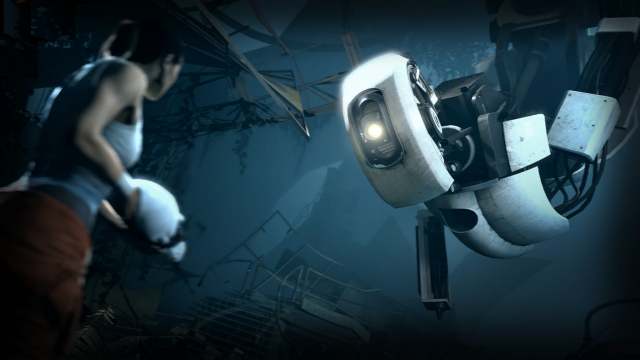
In some sort of miracle (Read: Steam Summer Sale), I’ve managed to play a game in the year it’s released. As with many others, the original Portal left a warm spot in my heart for a murderous robot. How could I resist the call of Portal 2? Though I tried, I couldn’t hold out for long.
Portal 2’s hype was through the charts by the time it launched. A collection of mysterious messages and seemingly random images from Valve began emerging on various online gaming publications. Portal was modified with new ending and extra game content that hinted of the upcoming sequel. It was beautiful marketing that promoted the game and rewarded fans. The hidden messages were fun, there was more to do in the game, and it was all laid out with just enough clues that the Valve community could piece it all together. A huge puzzle. Very appropriate.
The Potato sack thing was a bit over-the-top, I think, but still very fun. Play Steam games. Earn potatoes. The more potatoes earned, the more fuel GlaDOS has and the sooner Portal 2 will be released. Official and unofficial countdown sites popped up and a buzz formed as avid gamers watched the potato count go up… and rapidly descend. Is this a trick? Was it only a joke? Was GlaDOS using these potatoes for something?
Now, as it turns out, Portal 2 may have only been released a few hours early, but damn, Valve knows how to hype a game.
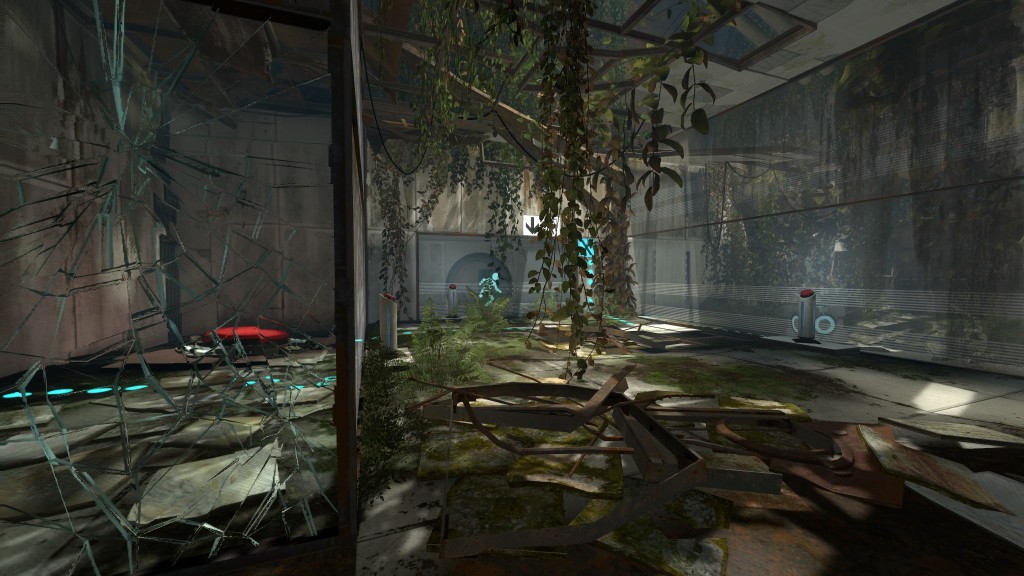 So Portal 2 kicks off a few, to use the technical term, zillion years after the first. Our female protagonist is awakened from a sleeping chamber and we’re introduced to a new character, Wheatley, right from the get go. This dude is a chatty, borderline annoying, accented fellow who holds the key to escaping the decaying Aperture Science labs. It’s an almost stereotypical sound, that of the blubbering Englishman who just can’t quite shut his mouth.
So Portal 2 kicks off a few, to use the technical term, zillion years after the first. Our female protagonist is awakened from a sleeping chamber and we’re introduced to a new character, Wheatley, right from the get go. This dude is a chatty, borderline annoying, accented fellow who holds the key to escaping the decaying Aperture Science labs. It’s an almost stereotypical sound, that of the blubbering Englishman who just can’t quite shut his mouth.
The humor immediately sets a different tone than that of the first game. In the original, much of the humor came from GlaDOS’s oblivious and callous testing procedures – a very sterile and matter-of-fact sense of being unawaredly humorous; it was much more subtle. Towards the end, it all got a bit silly, but for the most part, it wasn’t so in-your-face. A turret would gently yell, “I don’t hate you,” as it rolled over on the floor deactivated. Here in Portal 2, Wheatley is at times a fledgling stand-up comedian, repeatedly firing off jokes until there’s a response from the audience.
Granted, it had to be different. Portal 2 couldn’t be the original game with a new number behind it. It wouldn’t have worked. The mystery of the original was part of the fun. “What is this Portal thing that came with Half Life 2 in a mysterious orange box? A first-person puzzle game? What? Really, though, it was a trainer. Each stage showed a new trick and gave the player more control. First, you learn how a portal works, then you get to shoot one. What’s that crack in the wall with a note about cake? Never mind, now you get to fire a portal. Here’s a cube to hold down buttons. Here’s another obstacle. It was all just a training exercise for the final test: reaching GlaDOS herself. It was mystery that slowly revealed itself. In Portal 2, we’re all in on the secret already. To assume otherwise would be insulting.
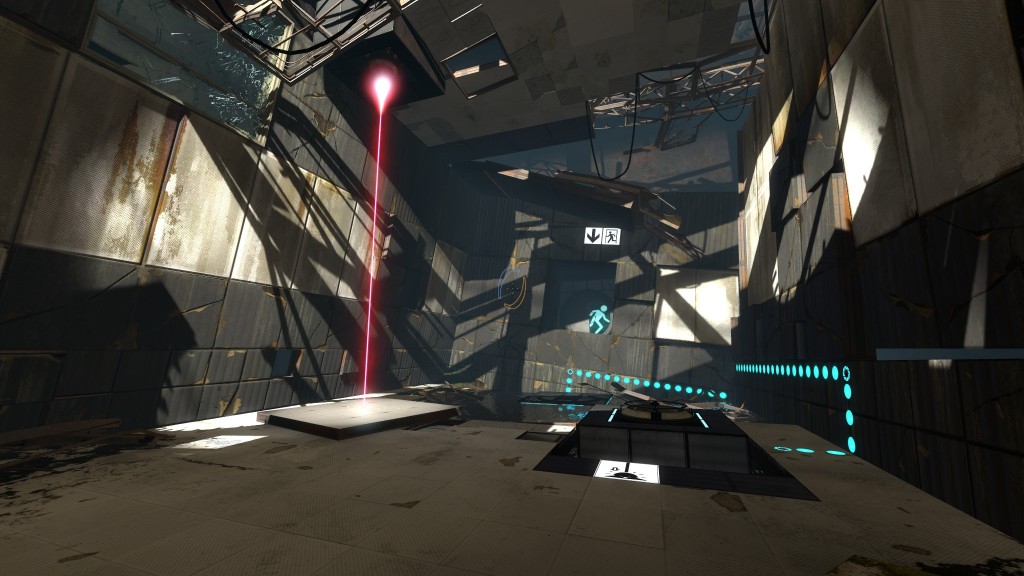 But to assume that everyone has played the original is also not true. So, after some initial fleeing, we get to revisit a few familiar puzzles from the original Portal, slightly damaged and with organic vegetation covering the walls. Time has not been kind to Aperture Science. It’s a quick refresher for veterans and an important training course for those new to the series. Best of all? More Wheatley.
But to assume that everyone has played the original is also not true. So, after some initial fleeing, we get to revisit a few familiar puzzles from the original Portal, slightly damaged and with organic vegetation covering the walls. Time has not been kind to Aperture Science. It’s a quick refresher for veterans and an important training course for those new to the series. Best of all? More Wheatley.
If the original Portal is the mystery, what is Portal 2? It’s the backstory. What’s the story of Aperture Science? Who runs this place? Why does GlaDOS exist? That’s what we get to see here, for those who are willing to stop and smell the roses and look. Not every game needs a gripping story, but it was so well integrated with the puzzles of the first game that it seems almost a requirement. Ultimately, though, Portal is about puzzles. How do we travel from point A to point B with a personal teleportation device?
Successfully solving a puzzle is what makes the game so rewarding. The thought process, thinking about how to connect the dots, struggling to create the dots, and then, best of all, the “Egad, I’ve got it!” moment from figuring it out and successfully executing the answer. The basic premise is the same: Fire two portals. Hop in one portal and transport to the location of the other one. Speedy thing goes in, speedy thing comes out. Get to the exit in one piece.
There’s a new set of obstacles and a few new tricks up the sleeves of Portal 2. The floating orb pellets are gone, and instead, substituted with lasers whose beams can be diverted to power up switches. Buttons are aplenty, but very few of them have timers on them. Floating bridges that sway back and forth are mostly eradicated as well.
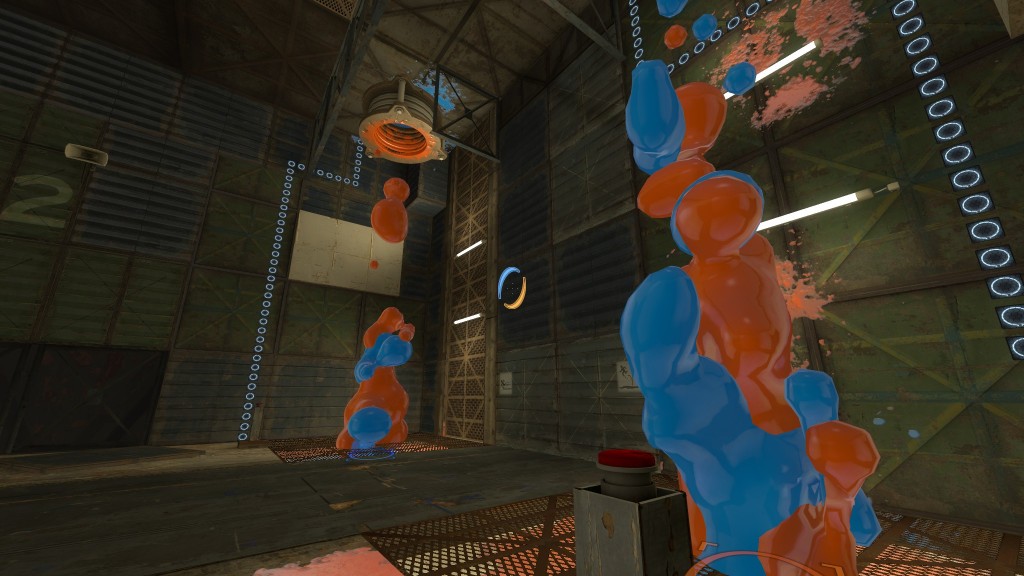 In lieu of some old hurdles, there are now gels that paint the walls will different movement effects. A blue gel allows for higher jumping, an orange gel for faster movement, a white gel that makes any surface portal-able (so that’s why those walls were always white…), and some water to remove said gels. There are also travel mechanisms: a light bridge that creates a pathway across large voids and a wind tunnel that will float the protagonist and other objects up down and all around the room.
In lieu of some old hurdles, there are now gels that paint the walls will different movement effects. A blue gel allows for higher jumping, an orange gel for faster movement, a white gel that makes any surface portal-able (so that’s why those walls were always white…), and some water to remove said gels. There are also travel mechanisms: a light bridge that creates a pathway across large voids and a wind tunnel that will float the protagonist and other objects up down and all around the room.
There had to be some new toys, but they also highlight another difference between the two games. The puzzle focus has shifted. As the original game marched to its finale, puzzles relied on trickier portal shooting skills – catching a glimpse of the barely visible wall that could attract a portal, using momentum and timing to fly through the air from floating platform to floating platform, portaling through moving banisters that would easily crush anything in their path.
Portal 2 drops most of the timing based activities and trick shots, instead opting to leave the mental aspects of solving the puzzle. There’s no feeling of, “I know how to do it, now I just need to get lucky enough to pull it off.” Instead, an open sea of deadly goo or a never-ending abyss is the primary enemy. It’s not a bad thing. Hardcore fans of the first game may expect more twitch-based puzzles, but the brainy aspects of the games – the best part – is still here in full glory.
The difficulty doesn’t quite ramp up the same way is it did in the original, but Portal 2’s puzzle variety and view of Aperture’s Science history keep it fresh. The single-player game alone is easily four to five times the size of the original Portal. Though there were early reports that Portal 2 was only four hours, it’s simply not true. There’s plenty of content here, and it’ll take some time and discovery to see every hidden piece.
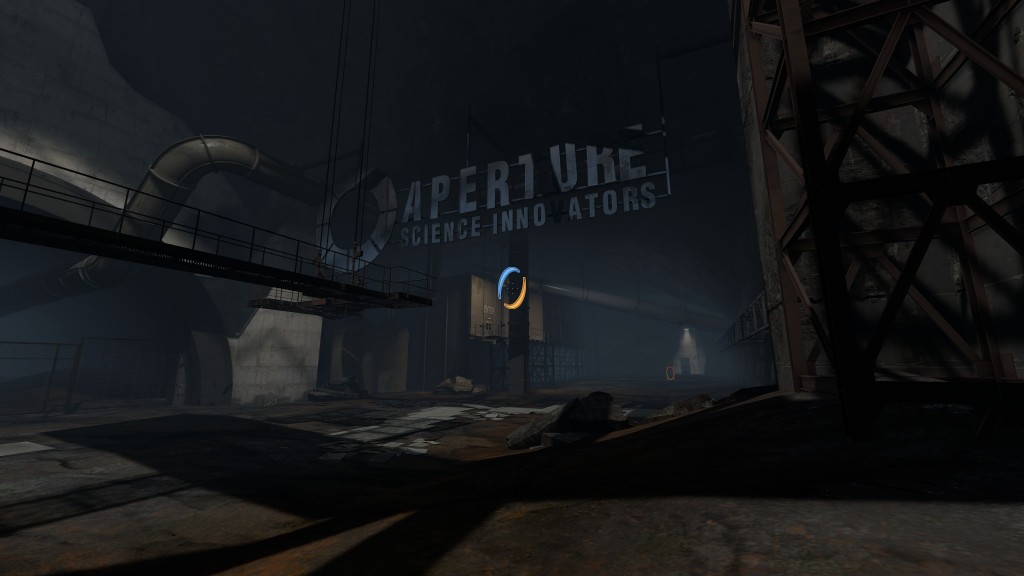 The overall feel of the game has shifted, too. Portal was very sterile, a direct effect of being in a testing laboratory. I imagine the game would smell like a hospital. It’s cold. Everything is clean. There is so much white it seems fake. The facade has been destroyed with Portal 2, displaying every bit of structure needed to build these white walls. Now we can see the factory-like nature of Aperture Science and its now dingy retro past. Traveling through Aperture’s historic annals quite reminded of Bioshock’s environments. The signs, motivational posters, and typography are very much in style of a 1940s Coca-Cola add – a different direction and one that I never expected to see in this series of games. I want to describe the feel as industrial – not in the sense of industrial music and the dark, repetitive computer sounds that come with it, but more like the proud “Buy American” factory workers like Rosie the Riveter.
The overall feel of the game has shifted, too. Portal was very sterile, a direct effect of being in a testing laboratory. I imagine the game would smell like a hospital. It’s cold. Everything is clean. There is so much white it seems fake. The facade has been destroyed with Portal 2, displaying every bit of structure needed to build these white walls. Now we can see the factory-like nature of Aperture Science and its now dingy retro past. Traveling through Aperture’s historic annals quite reminded of Bioshock’s environments. The signs, motivational posters, and typography are very much in style of a 1940s Coca-Cola add – a different direction and one that I never expected to see in this series of games. I want to describe the feel as industrial – not in the sense of industrial music and the dark, repetitive computer sounds that come with it, but more like the proud “Buy American” factory workers like Rosie the Riveter.
When the single player section is over, there’s co-op, too. Or, you can take my approach and start with the co-op first. Co-op is really fun and sometimes frustrating. Each player takes control of a robot with portal guns. Now, there are four simultaneous portals to be used, adding an extra layer of complexity to the puzzles. To help keep players in sync, gestures have been added. Markers, nav points, and timers are used to point out objects and spout directions. High fives, dances, and waves add some slap-stick to the robots.
Co-op is fun, but it’s not something that I’d want to do with a stranger. This is a game you’ll want to work through with a friend, or a least someone who you’re willing to engage in conversation. For me, there was a lot of, “Let’s try this,” and “Go here and try to shoot that,” as my co-op partner and I figured out how to tackle each puzzle.
GLaDOS may be more even more entertaining in co-op, as she seems to be back to here powerful, master-of-Aperture ways. She’ll play favorites. She’ll pit you and your partner against each other, taunting you both.
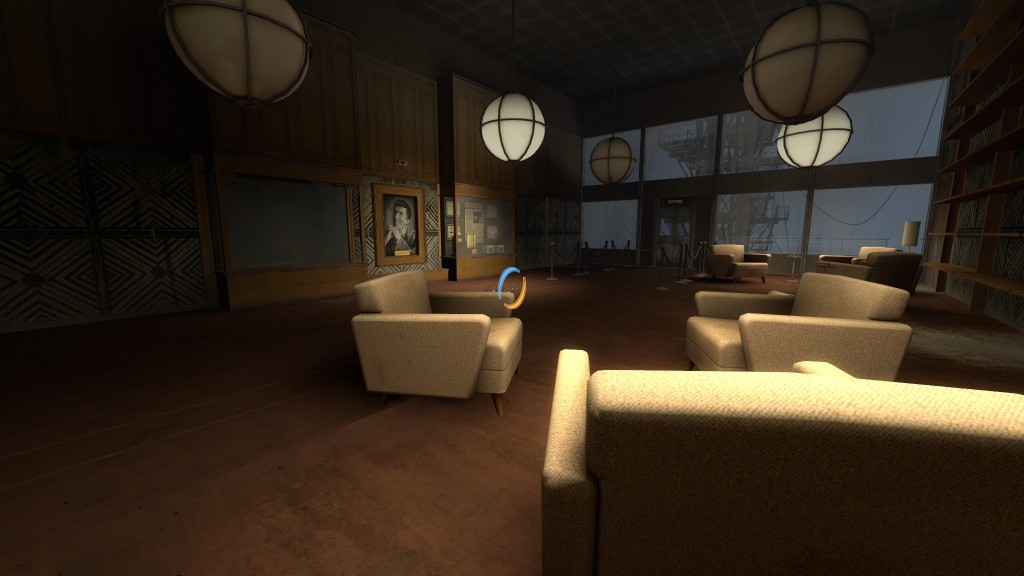 There are in-game transactions to buy different skins and flags for the robots, but these are a complete waste. Honestly, who cares if a robot is camo or has a flag hanging off it’s back? DLC and micro-transactions are supposedly the way of the future, but I think it’s completely unnecessary. Valve does well to keep it out of the way though, so unless you’re interested in such things, it can safely be ignored.
There are in-game transactions to buy different skins and flags for the robots, but these are a complete waste. Honestly, who cares if a robot is camo or has a flag hanging off it’s back? DLC and micro-transactions are supposedly the way of the future, but I think it’s completely unnecessary. Valve does well to keep it out of the way though, so unless you’re interested in such things, it can safely be ignored.
Portal 2 is probably set to be game of the year. It seems a safe lock in at this point. Is it fun? Absolutely. Both the single-player and co-op are a blast. For veteran players, it has lost a bit of the shock value of the first. Likely, there will be no memes spurting from Portal 2. But there doesn’t need to be. What’s in store is a familiar puzzle mechanism, more antagonizing (and sympathizing) with GLaDOS, new mechanics, and several times the amount of content.
« Prepare Carmageddon Returns » Local Ditch Gaming
Local Ditch Gaming